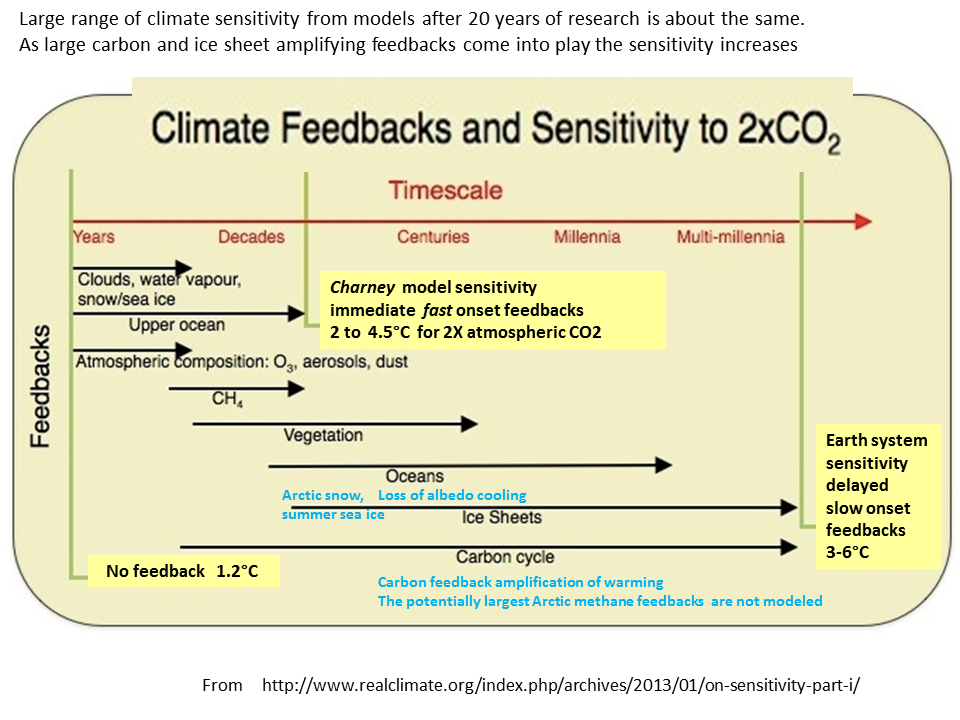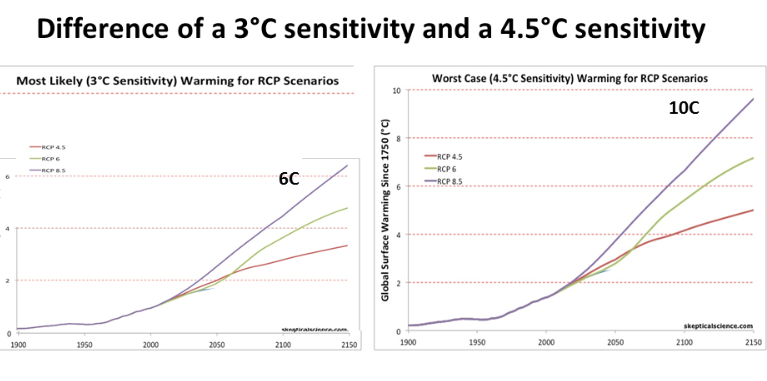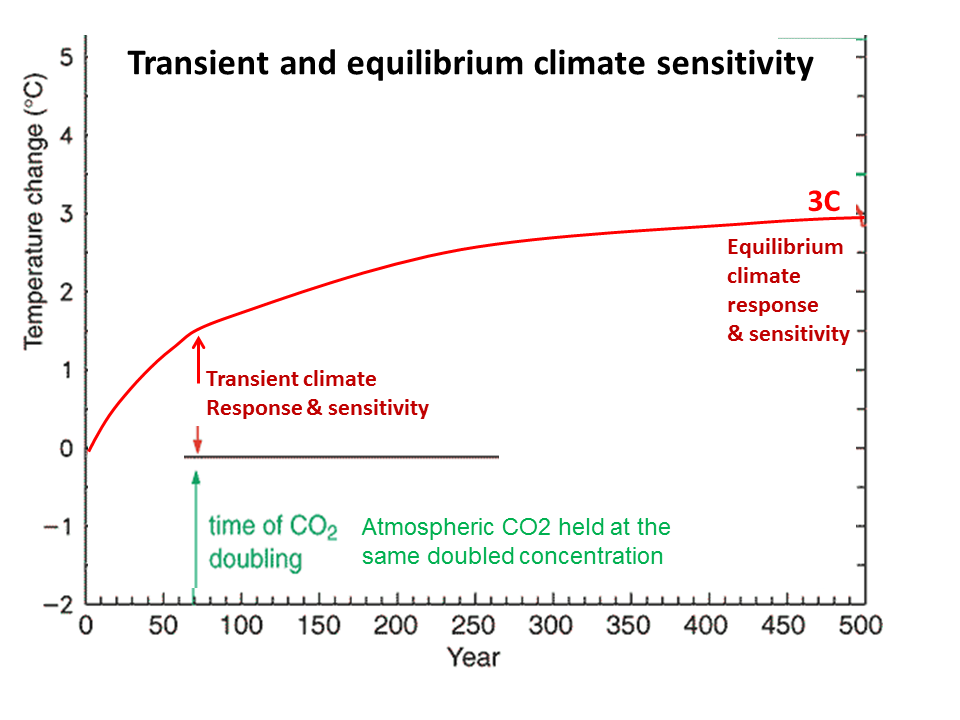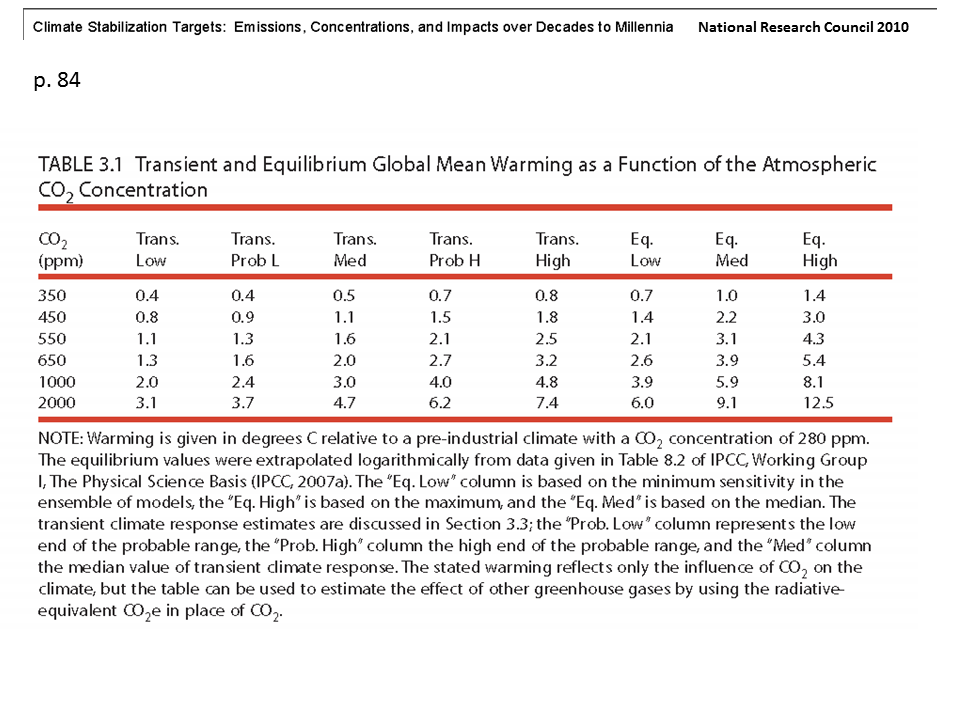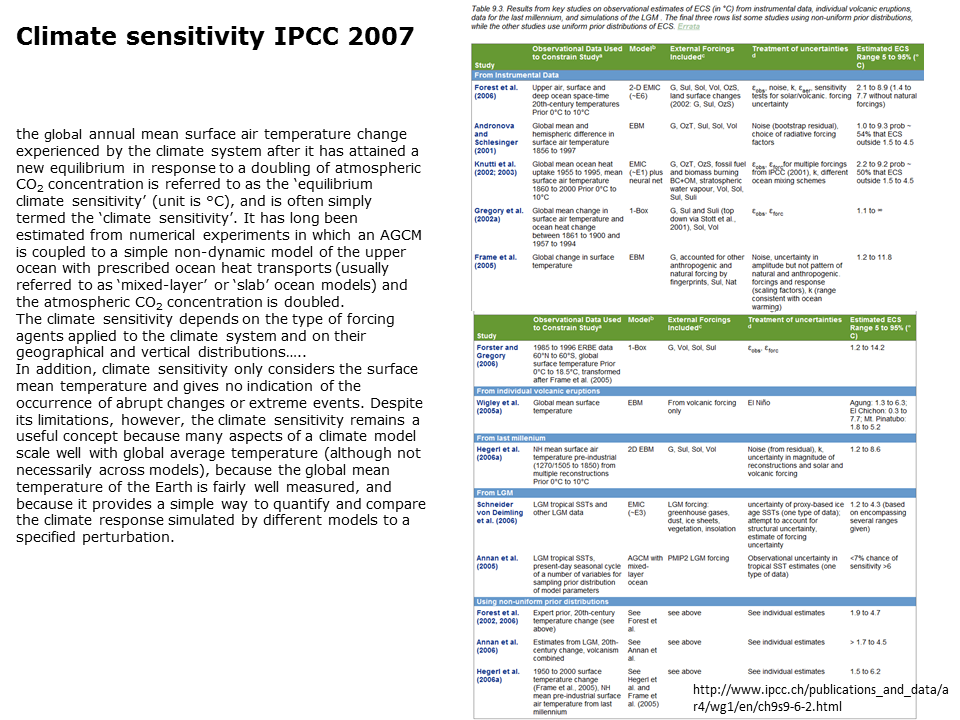Climate Change Knowledge.org

CLIMATE SENSITIVITY

Climate Change Knowledge
Climate sensitvity.
The climate sensitivity is a number that determines all of the climate change assessment because it defines how much warming is projected to occur as a result of additon of GHGs to the atmosphere.
The IPCC says It is broadly defined as the equilibrium global mean surface temperature change following a doubling of atmospheric CO2 concentration .
That may sound simple but it gets very complicated because there are many different numbers that may be used and there is great uncertainty about all the climate sensivity metrics that can be used.
To make sense of it the important fact is that the numder is a model number that gives a valuable indication of what the planet will do with more atmospheric CO2 but it is not a real world Earth number.
The IPCC says the greatest source of uncertainty in all climate science is the the amount of the climate sensivity.
The major work of climate change science is to increase the certainty of the sensitivity but is remains the same number used by the very first IPCC asssessment in 1990.
What about the other greenhouse gases? It is assumed that including the other GHGs (as the CO2 equivalent) would make no difference, though a climate sensitivity can be derived foir the other greenhouse gases. .
The climate sensitivity is determined by computer models and to a lesser extent by considering ice core records of the distant past (paleoclimate).
It is a metric used for moldel projections that does not reflect the real world situation for global warming past a few decades.
Though all the models for all projections use one senstiivity metric that number varies according to what the model is run for and by the climate feedbacks included in the model.
None of the feedback calculations however inclyude any carbon feedacks that add more warming as the global temperature increases. None of them account for abrupt or non linear temperature changes, which are features of the natural climate system.
Ever since the first IPCC assessment the siingle sensitivity metric used for the assessments has been three.
Transient and equilibrium sensitivity.
There are also two general numbers used that apply to all model results.
The temperature increase at the time of atmospheric CO2 doubling is called the realized
or transient sensitivity.
The number more generally used is the eventual long term temperature increase that the model
settles at, called the equlibrium climate sensitivity.
The equilibrium sensitivty is about double the transient sensitivity, and that has not changed since
the first 1990 IPCC assessment.
There are many different climate models from the world's climate research centers. They are programmed differently by the different science teams ideas of climate interactions.
Each tems climate model gives a wide range of results for the climate sensitivity and a mean is take from the range as the miost likely result.
The sensitivty of 3 (oC) is the result of taking the mean of the models (means).
The commonly used definition is still the original “Charney sensitivity” is the equilibrium surface temperature response to 2xCO2 allowing most atmospheric processes to react, but holding ice sheets, vegetation, atmospheric composition and ocean circulation constant - is a useful climate model metric for comparing the many different models. This cannot happen in the real world because warming caused by a doubling of CO2 will in time melt ice sheet release stores of carbon and alter ocean circulation. Among the included atmospheric processes are changing to water vapor (an amplifiying positive feed back) and clouds.
Climate sensitivity in fact inevitable increases over time as more feedbacks come into effect and increasingly so.
The IPCC 2007 gives a mean sensitivity of 3 but it could be over 4.5C
The equilibrium climate sensitivity is a measure of the climate system response to sustained radiative forcing. It is not a projection but is defined as the global average surface warming following a doubling of carbon dioxide concentrations. It is likely to be in the range 2°C to 4.5°C with a best estimate of about 3°C, and is very unlikely to be less than 1.5°C. Values substantially higher than 4.5°C cannot be excluded, but agreement of models with observations is not as good for those values. Water vapour changes represent the largest feedback affecting climate sensitivity and are now better understood than in the TAR. Cloud feedbacks remain the largest source of uncertainty IPCC 2007
The error of course at 50% if the sensitivity i the real world turns out to be 4.5 and not 3 is huge.
The climate sensitivity is a number that determines all of the climate change assessment because it defines how much warming is projected to occur as a result of additon of GHGs to the atmosphere.
The IPCC says It is broadly defined as the equilibrium global mean surface temperature change following a doubling of atmospheric CO2 concentration .
That may sound simple but it gets very complicated because there are many different numbers that may be used and there is great uncertainty about all the climate sensivity metrics that can be used.
To make sense of it the important fact is that the numder is a model number that gives a valuable indication of what the planet will do with more atmospheric CO2 but it is not a real world Earth number.
The IPCC says the greatest source of uncertainty in all climate science is the the amount of the climate sensivity.
The major work of climate change science is to increase the certainty of the sensitivity but is remains the same number used by the very first IPCC asssessment in 1990.
What about the other greenhouse gases? It is assumed that including the other GHGs (as the CO2 equivalent) would make no difference, though a climate sensitivity can be derived foir the other greenhouse gases. .
The climate sensitivity is determined by computer models and to a lesser extent by considering ice core records of the distant past (paleoclimate).
It is a metric used for moldel projections that does not reflect the real world situation for global warming past a few decades.
Though all the models for all projections use one senstiivity metric that number varies according to what the model is run for and by the climate feedbacks included in the model.
None of the feedback calculations however inclyude any carbon feedacks that add more warming as the global temperature increases. None of them account for abrupt or non linear temperature changes, which are features of the natural climate system.
Ever since the first IPCC assessment the siingle sensitivity metric used for the assessments has been three.
Transient and equilibrium sensitivity.
There are also two general numbers used that apply to all model results.
The temperature increase at the time of atmospheric CO2 doubling is called the realized
or transient sensitivity.
The number more generally used is the eventual long term temperature increase that the model
settles at, called the equlibrium climate sensitivity.
The equilibrium sensitivty is about double the transient sensitivity, and that has not changed since
the first 1990 IPCC assessment.
There are many different climate models from the world's climate research centers. They are programmed differently by the different science teams ideas of climate interactions.
Each tems climate model gives a wide range of results for the climate sensitivity and a mean is take from the range as the miost likely result.
The sensitivty of 3 (oC) is the result of taking the mean of the models (means).
The commonly used definition is still the original “Charney sensitivity” is the equilibrium surface temperature response to 2xCO2 allowing most atmospheric processes to react, but holding ice sheets, vegetation, atmospheric composition and ocean circulation constant - is a useful climate model metric for comparing the many different models. This cannot happen in the real world because warming caused by a doubling of CO2 will in time melt ice sheet release stores of carbon and alter ocean circulation. Among the included atmospheric processes are changing to water vapor (an amplifiying positive feed back) and clouds.
Climate sensitivity in fact inevitable increases over time as more feedbacks come into effect and increasingly so.
The IPCC 2007 gives a mean sensitivity of 3 but it could be over 4.5C
The equilibrium climate sensitivity is a measure of the climate system response to sustained radiative forcing. It is not a projection but is defined as the global average surface warming following a doubling of carbon dioxide concentrations. It is likely to be in the range 2°C to 4.5°C with a best estimate of about 3°C, and is very unlikely to be less than 1.5°C. Values substantially higher than 4.5°C cannot be excluded, but agreement of models with observations is not as good for those values. Water vapour changes represent the largest feedback affecting climate sensitivity and are now better understood than in the TAR. Cloud feedbacks remain the largest source of uncertainty IPCC 2007
The error of course at 50% if the sensitivity i the real world turns out to be 4.5 and not 3 is huge.
